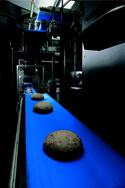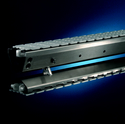Essential hygiene
19 May 2006The crucial link in well-run packaging lines, conveying systems also have to meet current hygiene standards, writes Pauline Covell
Unsung, almost invisible, yet absolutely essential – conveyors are to machinery lines what adhesives are to packaging materials. Like those adhesives, without them everything would simply fall apart. In addition to ensuring that each filling and packaging machine is supplied to run to its optimum ability, they speed up and slow down containers; they accumulate or single line; they elevate or descend and they protect product from knocks. Additionally, and increasingly importantly, they keep things up to today’s standards of cleanliness and hygiene.
Habasit, for example, has developed several products claimed to meet high hygienic standards and thus contribute to the quality and profitability of a production line. Says Olaf Heide, business unit manager for food and tobacco: “Hygiene is the key issue in any food processing and packaging plant. However, the hygienic design of the conveyor belts, which transport the food and parcels, is often too little considered.
“Conveyor belts play an important role in many food and packaging processes because they tie everything together. If they unexpectedly break down the whole production line can stand still. Downtime means costs, less output, order backlog and overtime. Conveyor belts convey not only move goods from A to B, but they also strongly influence productivity and can support or weaken hygiene and product safety.”
Several different plastic-based materials are used by the conveyor belting industry, for example PVC, PU, PE, PP and silicone and blends. “The right choice of raw material for its intended use is the first pillar of hygiene,” explains Heide. “The weakest element can harm the whole system. All materials likely to be directly exposed to food have to fulfil strict regulations. Whether the manufacturer produces coated fabric belts, multilayer constructions with a reinforcing fabric with top and sometimes reverse side coating, or extruded plastic modular belts, they must understand the specific needs of the target industry and their application in order to design reliable products.”
Synthetic conveyor belts are wear-parts. Even if they are carefully selected, surface abrasion, cuts, scratches or micro-cracks can appear over time, says Habasit. Polyurethanes or PE do not act as nutrients for micro-organisms, but regardless of sophisticated HACCP systems and cleaning procedures, bacteria harboured in little cracks of micrometer size cannot be controlled. In a food processing plant in particular these micro-organisms will find plenty of opportunity to multiply.
“Cleaning agents or aggressive detergents actually accelerate the wear effects on plastics. If abraded surfaces are directly exposed to food this increases the risk of contamination - a serious hygiene problem,” adds Heide. “Just how do you break this vicious circle? We offer several solutions that provide an additional hurdle for micro-organisms. Intensive studies are made to simplify the cleaning and to set new standards in hygienic food and packaging conveyors and we constantly verify new ideas to support hygienic food processing with customers and industry associations such as EHEDG, CCFRA and VDMA.”
Habasit offers both fabric and plastics modular (HabasitLINK) belts. For additional safety it has introduced an oil and fat-resistant food PVC HySAN, and HyGUARD and HabaGUARD conveyor belts that contain an antimicrobial additive. Its Cleanline food belts are coated with a modified polyolefin (Habilene), which was developed to improve the release properties of sticky foodstuffs. By installing Cleanline a company that produces puff pastry products reduced the consumption of flour (added to help product release) by more than 30%, reports Olaf Heide. Another food processor that formerly lost substantial amounts of production through product stuck on conveyor surfaces has reportedly reduced this by 90%.
Conveyor belts may be made hygienic by applying calender coating technology to produce smooth, sealed, homogeneous and non-porous surfaces that discourage bacteria, micro-organisms and food residues. Reverse side coating, impregnation of reverse side fabrics and edge sealing helps to avoid permeation of oil, fat, product particles or moisture into the traction layer. “Anti-static finish reduces the build-up of dust and dirt. And conveyor belts with blue coatings improve product safety,” says Heide. “Blue is a colour that rarely exists in foodstuffs so foreign particles can be easily detected in the product. There is better assessment of cleanliness of processing lines. Remaining food residues are more visible on a blue conveyor belt”.
Hanover-based specialist Siegling also agrees that blue conveyor belts are gaining ground in the food industry. “For decades the colour white meant hygiene. That’s why conveyor and processing belts in the food industry were almost always white. Recently however an interesting trend has emerged: more and more businesses are converting to blue belts – and that has nothing to do with fashion,” says the company.
The striking contrast to the goods conveyed means that soiling is recognised more easily and at an earlier stage, it points out. And optically controlled sorters commonly used on packaging lines depend on an ideal contrast and require blue as a background colour. Blue also reflects light less in comparison to white, providing pleasanter working conditions adds Siegling.
The company is now offering a whole range of types in blue which cover the majority of conveying processes in the food industry. It can provide blue products for curves, inclined and accumulated conveying, knife edges and even elastic spreading belts. The range covers both fabric-based synthetic belts an modular belts (link-chain belts). Its HACCP product types are designed for particularly hygiene-sensitive operations.
Recently launched is its Series 6, a polyacetal and polyethylene product in the ProLink modular belt range specially designed for those operations. An easy to clean module, the design has avoided all "undercuts", right angles or other problem areas. The sprockets and engagement points in the module are designed so that they can be easily rinsed through. The standard modular width is 400mm. This is also important for hygiene because wide modules mean fewer connecting points and therefore fewer dirt traps.
Following this increased attention on hygiene in the food and dairy industry, Swedish conveyor specialist FlexLink has launched the second generation of its modular hygienic conveyor concept. The design is claimed to establish new levels of hygiene and productivity in filling and packaging lines. “The equipment has been verified by leading international dairy groups as being crucial for plant efficiency in strictly hygienic environments,” claims FlexLink.
The company says that the latest development follows on from its hygienic concept, which has doubled sales in the past year. Featuring open and self draining surfaces, the design eliminates lubrication and allows for what it claims are the highest chain conveyor speeds in the market. As lubrication is eliminated there is no contamination of the products conveyed and costs of lubricants and their supply systems are saved. The new chain, combined with improved conveyor rigidity, provides for speeds of up to 100 metres/min, while still maintaining the stability of the products conveyed. Speed control has been integrated into the drive units, allowing dynamic buffering and soft start and stop.
An optional automatic Cleaning In Place (CIP) system can be easily attached to the stainless steel conveyor. FlexLink says this “reduces consumption of hot water by 50%, detergents by 80% and increases line uptime by up to 5% by eliminating the industry standard manual hose-down cleaning procedure.” The equipment is CE compliant and has been designed in accordance with the guidelines of the European Hygienic Engineering & Design Group.
Based on the hygienic conveyor system FlexLink has also announced its Dynamic Line Balancing concept for dairy production. Offering high volume distribution systems between fillers, tray packers and palletizers for mixed production in dairies, it is designed to give increased machine utilisation, full routing flexibility and process control.
The overall target for the Dynamic Line Balancing concept is to increase line utilisation ultimately to 95%. For the first time in the dairy industry, mixed line production with flexible tray packaging and palletizing together with full process control is made possible, says the company.
The development is actually based on FlexLink’s patented Dynamic Flow Concept for the tissue paper converting industry, where requirements for on-the-fly diverters and mergers are becoming the industry standard. The modularity of the line concept allows for step-by-step automation, which will give producers a tool to invest in equipment in accordance with their volume development.
The concept has been designed for continuous product flow through different temperature and hygiene zones of the plant, thereby contributing to a longer product shelf-life.
The company has also launched a patented automatic product guiding system that is said to solve a long-standing productivity bottleneck in conveyor lines. Line output will increase and the payback time of the investment may be less than a month if resetting is required five times a week, explains FlexLink. “The system makes efficient multi-product manufacturing lines a reality. Automatic resetting of the lines makes for increased line utilisation with small production runs.”
At the core of the system are the electrically driven guiding units that control the position of the guide rails along the line. Up to 220 guiding units can be controlled from one cabinet and a repetitive accuracy of less than +- 0.1mm is claimed. Major installations have been completed in Europe and the USA.
But the breeding of micro-organisms in the machinery is not the only major concern when conveying foods, beverages or pharmaceuticals, says Belt Technologies Europe, as there is also the potential for spreading pathogenic micro-organisms. “Pre-requisites, therefore, are non-corrosive materials which are easy to clean and are free from crevices that are potential dirt traps.”
“Traditional conveyor types employing chains, plastic and PU belts are, however, still employed despite the potential risk to contaminants”, says the company. “In Germany, a number of food products had to be recalled as they had become contaminated by the chain lubricant in the manufacturer’s machinery. Germs and potentially harmful bacteria are attracted to the dust gathered by the lubricant grease which can be transported and fall in the food during the manufacturing process.”
Belt Technologies believes the use of steel belts can overcome the variety of cleanliness problems faced by users of conventional belts in the food industry. Steel belts are “easy to clean and can be made from a number of stainless steel grades – such as 304 FH and 316 FH – which possess very high anti-corrosion properties”. The company says wash-down with corrosive fluids is common place in applications such as the transportation of dairy products. Moreover, steel belts do not need lubrication in order to transmit power and are free from particulate. They can also be customised in a number of ways, for example belts can be designed with complex perforation patterns for timing, vacuum and dosing applications.
Aimed at addressing the food hygiene issue Rexnord has introduced its 1010-series modular conveyor belts. The design of the 1in pitch belt emphasises ease of cleaning. In the hinge area in particular the company says the highest level of accessibility of the pin has been achieved. Water can flow around the complete pin and the hinge design covers a minimum amount of the pin surface. The curved bottom of the belt is able to drain the cleaning and sanitizing liquids easily, so that it will dry quicker. It is equipped with Microban antibacterial protection as standard.
Wire Belt Co has introduced a belt to handle small, delicate products, while providing a lower mass, open-mesh belt design that is said to be ideal for high speed cooling and drying operations. The lighter weight makes Compact Grid a more energy-efficient solution than other conventional conveyor belts, says the company. It is engineered with a 70% open surface area and is claimed to be easy to clean and maintain. Said to offer a much tighter wrap capability than most friction-drive metal beltings, it allows for improved conveyor-to-conveyor transfers and minimises the chance of product yield loss in high speed processing operations.







